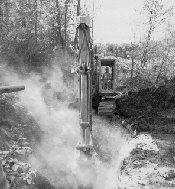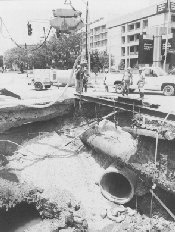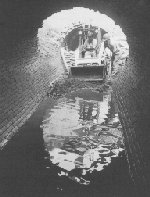The 1990s would become the busiest period in MSD’s history. As the decade began, the $25 million in drainage bonds were sold, and construction started on major drainage improvements. Construction also started on the North County sanitary sewer expansion plan, with work on the force mains and the lines needed to eliminate the Muddy Fork treatment plant.
June, 1990 also brought a spectacular collapse of the old brick sewer line at Preston and Broadway; it closed the busy downtown intersection for more than four weeks.
The Challenges Of The ’90s
MSD’s annual reports of the early 1990s focused on the major challenges in the years ahead. They were updated descriptions of the challenges MSD had been facing for the past four decades: sanitary sewer expansion, sewage treatment, and drainage improvement. There was, however, a major change: programs were now in place to address all of the issues. Among them:
- Drainage. Between 80 and 100 neighborhoods were suffering major drainage or flooding problems during heavy rains; the $25 million bond issue would correct only some of these problems. And relieving flooding would not be enough; new federal standards would require measures to reduce the pollution in stormwater entering the streams.
- Sanitary Sewer Service. In 1990, more than 25,000 homes in Louisville and Jefferson County were still on septic tanks; many more homes and businesses were served by small treatment plants. Extending MSD service to these areas was an ongoing priority. Another priority was upgrading the Morris Forman treatment plant to assure adequate capacity and adequate treatment. And there were two major challenges in stopping stream pollution in wet weather: developing ways to deal with combined sewer overflows, and finding and eliminating sources of stormwater entering sanitary-only sewers.
- Infrastructure Rehabilitation. About 200 miles of sewer lines, or about ten percent of the system, were more than 100 years old — and the oldest parts of the system served the most customers. Inspecting, maintaining and rehabilitating these lines would become more and more expensive.
- Water Quality Programs. The continuing national effort to clean up the streams would require expansion and improvement of MSD’s local water quality programs, including industrial pretreatment of wastewater and the hazardous materials program. It would also require continuing monitoring of local streams to measure water quality and detect sources of pollution.
- Financing. Major federal funding of local sewer projects had virtually ended, after providing more than $100 million for MSD programs in the previous two decades. In the future, the money would have to come from local sources — including the money needed to meet increasing federal clean-water standards. A major exception would be U.S. Army Corps of Engineers involvement in flood control studies and programs along local streams, including Pond Creek and Beargrass Creek.

Construction equipment, pipes and holes in the ground characterized MSD in the 1990s, as drainage and sanitary sewer expansion projects brought long-needed and long-delayed improvements to neighborhoods throughout Louisville and Jefferson County.
MSD Photo by Martin E. Biemer
The Drainage Program
The drainage program began in 1987 with high expectations. People who had suffered drainage problems over the years — and had often seen their complaints shuffled from agency to agency without action — welcomed the idea that one central agency would now be responsible, and would be able to act.
The new program began with about 1,500 historical requests for drainage improvements from Louisville, Jefferson County, and MSD’s own files. As the program began, these requests had multiplied tremendously — to a total of more than 14,000 in the first six months, and to more than 30,000 in the first four years.
Most of the requests involved maintenance problems — clogged catch basins, cave-ins, pipes and ditches — that could be resolved relatively quickly. But a significant number would require new construction. MSD was able to complete nearly $2.5 million in small, neighborhood "mini" drainage projects in its first four years, but the large projects had to wait until additional funding could be secured.

June 1990 brought one of the largest sewer collapses in MSD's history. A break in the eight-foot-diameter Broadway interceptor, built of brick in 1872, allowed the earth beneath the intersection of Broadway and Preston to wash away, creating a giant cave. A hole in the pavement caught the attention of the police, who called MSD, which sent an inspector, who shone a flashlight around in the hole — and the intersection was closed immediately. Repair work was soon under way with chains temporarily supporting a major water main.

A small power shovel (left) was used to clean the debris out of the collapsed Broadway line.
MSD Photos by Martin E. Biemer
The result: while MSD was able to resolve nearly 22,000 requests in the first four years of the drainage program, the backlog of unresolved requests grew to more than 8,000.
While the backlog of requests was building, the scope of the problems was becoming more evident — and more daunting. By early 1991, MSD had identified more than 100 areas that would need major construction projects to deal with their drainage problems. The $25 million bond issue had been designed to cover 52 projects.
As the drainage program neared the end of its fifth year, the pressures were building. Citizens with severe drainage problems were growing increasingly impatient. MSD didn’t have enough income to finance the growing list of needed improvements.
In late 1991 the MSD Board began discussing an increase in the drainage fee. In January, 1992, the Strategic Planning and Financing Committee, which originally had recommended that MSD take over the drainage program, was reconvened to study the situation.
Meanwhile, citizens had been complaining to their state representatives and senators about MSD’s responses to requests for drainage improvements. Some legislators complained that they couldn’t get satisfactory answers from MSD. A bill was introduced in the state legislature to allow any citizen to appeal any MSD decision to the Louisville Board of Aldermen or to Jefferson Fiscal Court.
The dispute continued for several months, and was resolved when MSD took two major steps:
- It set up a grievance procedure, allowing any citizen to appeal an MSD action to the MSD Board (whose members were appointed with the agreement of the Board of Aldermen and Fiscal Court); and
- It set up a five-year program of planning and tracking the progress of every proposed drainage project, so that citizens and public officials alike could find out the details of the plans and their current status.
In May, 1992, MSD announced that the money from the $25 million bond issue would run out after only 40 of the original 52 projects were completed; the remaining 12 projects would have to wait for future financing. Then MSD prepared a revised list of needed drainage projects, detailing more than 170 (including the 12 that had been deferred). It proposed a five-year schedule for completing them — using more than $40 million in new bonds, to be repaid from an increase in the drainage fee.
In September, the Strategic Planning and Finance Committee recommended that the basic rate of $1.75 per residential unit per month be increased to $2.75. MSD explained the drainage program and the need for the increase at 40 community meetings and six public hearings. On December 1, 1992, the increase went into effect — with the consent of the Board of Aldermen and Fiscal Court.
And in January, 1993, MSD approved a revised list of more than 200 drainage projects to be completed within the following five years; $48 million in bonds were issued to finance planning and construction.
The five-year program was detailed in a loose-leaf handbook that was distributed to all elected officials in Louisville and Jefferson County and was made available to the public for examination at MSD’s offices.
"I think that was a major turning point," said Sandra J. Metts, who was chairperson of MSD’s Board from mid-1992 to mid-1997. "Before, the legislators didn’t know what MSD was doing. They’d get complaints from constituents, and we weren’t being responsive to them."
Using the new book of projects, she said, "they could answer questions. They had a road map to go by."
MSD History continued - The August, 1992 Flood


